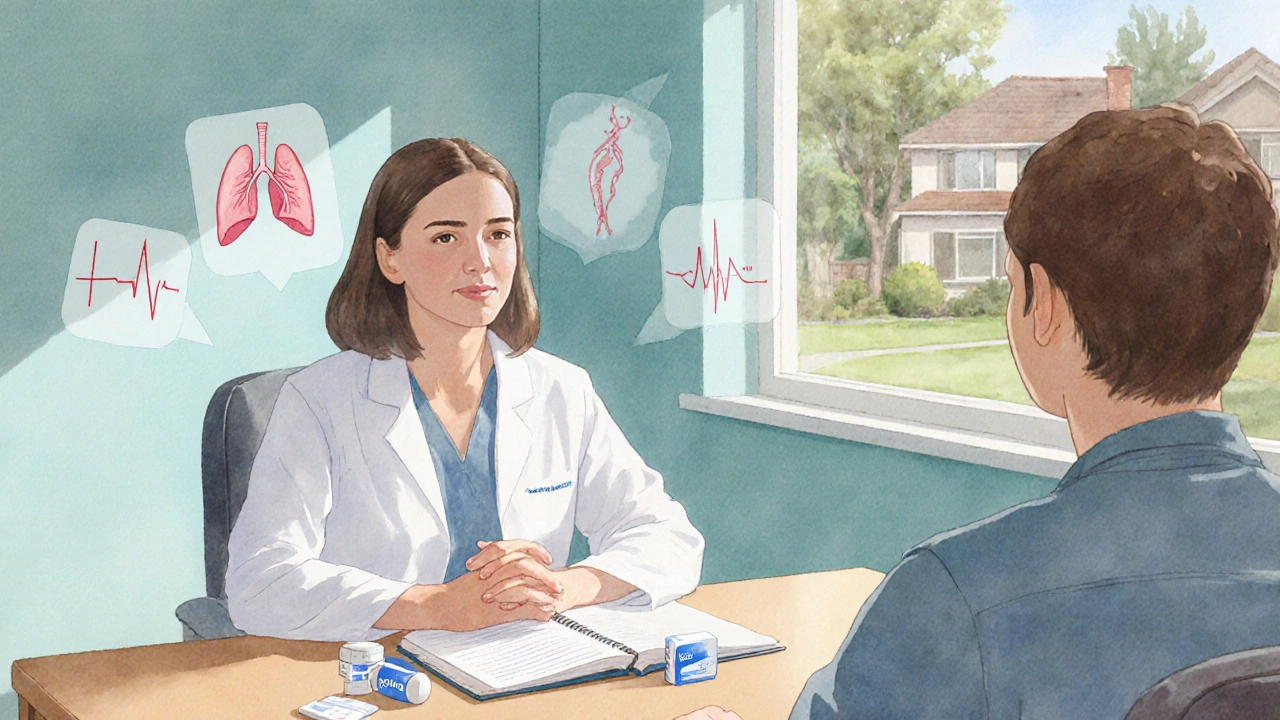When an infection strikes, the first question is often: which pill will clear it up fastest and safest? Baycip is a branded oral ciprofloxacin tablet that belongs to the fluoroquinolone class, widely used for urinary‑tract, respiratory and skin infections. But it’s not the only player on the shelf. This guide breaks down Baycip’s strengths, weak points, and how it stacks up against other common antibiotics you might see on a prescription label.
What Makes Baycip (Ciprofloxacin) Tick?
Ciprofloxacin is a synthetic broad‑spectrum antibiotic that interferes with bacterial DNA gyrase and topoisomerase IV, halting DNA replication. The branded version Baycip comes in 250mg and 500mg tablets, typically taken twice daily for 7‑14days depending on infection severity. Its rapid absorption (peak plasma in 1‑2hours) and good tissue penetration make it a go‑to for gram‑negative pathogens like E. coli and Pseudomonas aeruginosa.
Key Criteria for Comparing Antibiotics
- Spectrum of activity: Which bacteria are covered?
- Dosage convenience: How many pills per day?
- Side‑effect profile: Risk of tendinitis, QT prolongation, etc.
- Drug interactions: CYP450 involvement, metal ion binding.
- Resistance trends: Local antibiogram data.
- Cost & insurance coverage: Out‑of‑pocket price.
Head‑to‑Head Comparison Table
| Attribute | Baycip (Ciprofloxacin) | Levofloxacin (Levaquin) | Azithromycin (Zithromax) | Amoxicillin (Amoxil) | Doxycycline (Doryx) | Bactrim (Trimethoprim‑Sulfamethoxazole) |
|---|---|---|---|---|---|---|
| Spectrum | Broad gram‑negative + limited gram‑positive | Broad gram‑negative & gram‑positive | Primarily atypical & some gram‑positive | Gram‑positive > gram‑negative | Broad, good for intracellular bugs | Broad, strong against E. coli, Staph |
| Typical Dose | 500mg BID | 500mg QD | 500mg on day1, then 250mg daily | 500mg TID or 875mg BID | 100mg BID | 800mg BID |
| Course Length | 5‑14days | 5‑10days | 3‑5days (azithro) or 7‑10days | 7‑10days | 7‑14days | 5‑7days |
| Common Side Effects | Tendon pain, QT prolongation, GI upset | QT prolongation, CNS effects | GI upset, mild liver enzyme rise | Rash, GI upset | Photosensitivity, esophagitis | Rash, hyperkalemia |
| Key Interactions | Antacids, calcium, iron, warfarin | Antacids, CYP1A2 inhibitors | Antacids (minor), warfarin | Probenecid, oral contraceptives | Calcium, iron, antacids | ACE inhibitors, potassium‑sparing diuretics |
| Resistance Concerns | Rising fluoroquinolone resistance in UTIs | Lower resistance than ciprofloxacin | Macrolide resistance in S. pneumoniae | β‑lactamase producers | Variable, especially in rickettsial diseases | Resistance in MRSA strains |
| Average US Price (out‑of‑pocket) | $20‑$30 for 14‑tablet pack | $25‑$35 | $15‑$25 | $10‑$20 | $12‑$22 | $18‑$28 |

When Baycip Might Be the Right Choice
If you’ve been diagnosed with a complicated urinary‑tract infection (cUTI) or a skin infection caused by Pseudomonas, the fluoroquinolone class often outperforms other oral agents because of its strong gram‑negative coverage and excellent tissue penetration. Baycip’s twice‑daily regimen can be easier for patients who struggle with three‑times‑daily pills. It also reaches high concentrations in bone, making it a viable option for osteomyelitis when IV therapy isn’t possible.
Popular Alternatives Explained
Levofloxacin shares the fluoroquinolone backbone but offers once‑daily dosing and a slightly broader gram‑positive reach, which can be helpful for community‑acquired pneumonia. Azithromycin is prized for its short 3‑day course and good activity against atypical organisms like Mycoplasma, but it lacks robust gram‑negative power. Amoxicillin remains the first‑line for many sinus and ear infections because of its safety record, though it’s ineffective against resistant gram‑negative rods.
Doxycycline is a tetracycline useful for tick‑borne diseases and acne; its side‑effect profile includes photosensitivity, which can be a deal‑breaker for outdoor workers. Bactrim (trimethoprim‑sulfamethoxazole) hits many urinary pathogens and some MRSA strains, but it can trigger kidney issues in patients on diuretics.
How to Pick the Best Option for You
- Identify the suspected or confirmed bug. A culture result pointing to a fluoroquinolone‑sensitive E. coli makes Baycip a strong candidate.
- Check your personal risk factors. History of tendon problems, prolonged QT interval, or pregnancy rules out fluoroquinolones.
- Look at drug‑interaction red flags. If you’re on iron supplements or antacids, you may need to separate dosing by at least 2hours.
- Consider convenience. Once‑daily levofloxacin beats twice‑daily Baycip for adherence, especially in older adults.
- Factor in cost and insurance. Generic ciprofloxacin is cheaper than brand‑name Baycip, but some plans cover Baycip at the same tier as generic levofloxacin.

Safety Tips and Common Pitfalls
Fluoroquinolones carry a boxed warning for tendon rupture, especially Achilles tendon in athletes or older adults. If you feel sudden calf pain, stop the medication and call your doctor. Another concern is the potential to prolong the QT interval; electrolytes (potassium, magnesium) should be checked if you’re also on anti‑arrhythmic drugs. Finally, avoid self‑treating without a prescription-using Baycip for viral infections offers no benefit and fuels resistance.
Quick Takeaways
- Baycip provides strong gram‑negative coverage, ideal for UTIs and certain skin infections.
- Levofloxacin offers similar power with once‑daily dosing.
- Azithromycin is best for atypical respiratory bugs but lacks gram‑negative strength.
- Amoxicillin, doxycycline, and Bactrim each have niche uses where they outperform fluoroquinolones.
- Weigh side‑effects, drug interactions, and personal health history before choosing.
Frequently Asked Questions
Can I switch from generic ciprofloxacin to Baycip?
Yes, the active ingredient is the same. The main difference is the brand’s tablet coating and price. Some patients prefer Baycip for its easier swallow, but therapeutic effect remains identical.
Is Baycip safe for pregnant women?
Fluoroquinolones are generally contraindicated during pregnancy because of potential cartilage damage in the fetus. Discuss alternatives like amoxicillin or cefuroxime with your obstetrician.
How long does it take for Baycip to start working?
Patients often notice symptom relief within 48‑72hours as bacterial load drops. Complete eradication usually requires the full prescribed course, even if you feel better sooner.
Can I take Baycip with a calcium supplement?
Calcium can bind to ciprofloxacin in the gut and reduce absorption. Space the doses at least two hours apart to keep effectiveness high.
What should I do if I develop a rash while on Baycip?
Stop the medication immediately and contact your healthcare provider. A rash could signal an allergic reaction, and switching to a different antibiotic class may be necessary.


Warren Workman
October 5, 2025 AT 18:14Despite the exhaustive table, the pharmacokinetic metrics of Baycip are overrated when you consider the real-world emergence of plasmid-mediated resistance.
Kate Babasa
October 8, 2025 AT 01:47Indeed; while the data is comprehensive, one must also weigh the clinical pragmatism-cost, patient adherence, and local antibiograms-before defaulting to any “gold standard.”
king singh
October 10, 2025 AT 09:21Baycip’s twice‑daily dosing can be a hurdle for some patients, but its tissue penetration is unmatched for complicated UTIs, which is why many clinicians still keep it in their formulary.
Michelle Dela Merced
October 12, 2025 AT 16:54🔥💥Yo, if you’re an American and your doc prescribes Baycip, you’re basically getting the “Made‑in‑USA” advantage-no foreign‑made loopholes, just straight‑up power!🇺🇸
Alex Iosa
October 15, 2025 AT 00:27It is crucial to recognize that the pharmaceutical lobby exerts pressure on prescribing habits, subtly steering clinicians toward brand‑name products like Baycip under the guise of superiority, despite equivalent generic efficacy.
melissa hird
October 17, 2025 AT 08:01Ah, yes-because nothing screams “expert opinion” like a sarcastic nod to corporate branding while ignoring the fact that the active moiety remains unchanged across formulations.
Mark Conner
October 19, 2025 AT 15:34Look, if you’re sick of foreign meds, Baycip is the home‑grown answer, no need to trust some overseas generic that might be half‑filled.
Charu Gupta
October 21, 2025 AT 23:07While enthusiasm is appreciated, one must correct the misconception: the bioavailability of ciprofloxacin is not contingent upon its country of manufacture but rather on its chemical stability and proper dosing intervals.
Abraham Gayah
October 24, 2025 AT 06:41Honestly, the whole debate feels like a high‑school cafeteria argument-people shouting about “big pharma” while ignoring the fact that the real hero here is the drug’s ability to penetrate bone tissue when you need it most.
rajendra kanoujiya
October 26, 2025 AT 14:14But that’s exactly the point: people glorify Baycip’s bone penetration without acknowledging the rising fluoroquinolone resistance that renders that advantage moot in many regions.
Beverly Pace
October 28, 2025 AT 21:47From an ethical standpoint, prescribing a brand‑name antibiotic when a generic is available raises concerns about healthcare equity and unnecessary financial burden on patients.
RALPH O'NEIL
October 31, 2025 AT 05:21Could we perhaps explore whether the marginal cost difference truly impacts outcomes, or if the perceived brand value merely influences patient confidence without clinical benefit?
Mark Wellman
November 2, 2025 AT 12:54Okay, so listen up – I’ve been reading these antibiotic guides for hours and honestly it feels like a never‑ending maze of numbers and side‑effects that nobody really gets to finish. First off, Baycip’s got that fancy twice‑a‑day schedule that sounds convenient until you remember you’ve got a 9‑to‑5 job and a kid who needs dinner at six. Then there’s the whole tendon‑rupture warning that sounds like something out of a superhero movie, but hey, who’s got time to worry about a tendon when you’re battling an infection? And don’t even get me started on the QT prolongation thing – it’s like the drug is saying “hey, let’s mess with your heart rhythm for fun”. Also, the drug‑interaction list reads like a grocery list: calcium, iron, antacids, warfarin… you might as well be cooking a stew. On top of that, the resistance trends are climbing faster than a pop chart, especially with E. coli learning to dodge fluoroquinolones like a pro gamer. Meanwhile, generic ciprofloxacin is sitting on the shelf for a fraction of the price, doing exactly the same job, which makes me wonder why anyone would pay premium for a brand name. The table in the article is helpful, but it won’t tell you how many times people actually miss doses because they forget the two‑hour separation from calcium supplements. And let’s be real – most patients don’t even read the fine print; they just pop the pill and hope for the best. If you’re a clinician, you’ve got to balance the scientific data with the reality that people often forget to finish the course, leading to even more resistance. So, yeah, Baycip might be a solid drug, but it’s not the only player in the arena, and sometimes the cheapest option does the job just fine. Bottom line: weigh the pros and cons, talk to your doctor, and don’t let the brand name hype dictate your prescription. In practice, I’ve seen patients switch to a generic just because their insurance denied the brand, and they recovered without a hitch. That anecdote alone should make us question whether brand loyalty is medically justified. Ultimately, the decision should hinge on microbial susceptibility, patient tolerance, and cost, not on flashy packaging.
Amy Morris
November 4, 2025 AT 20:27Reading that exhaustive rant reminded me of a friend who suffered a tendon tear after a fluoroquinolone course, and it truly hit home-pain is no joke.
Francesca Roberts
November 7, 2025 AT 04:01Sure, Baycip is “the best” until you realize the generic does the exact same job for half the price-classic pharma hype, lol.
Becky Jarboe
November 9, 2025 AT 11:34Considering the pharmacodynamic parameters, could the once‑daily levofloxacin achieve comparable AUC/MIC ratios in urinary pathogens without increasing adverse events?
Carl Boel
November 11, 2025 AT 18:14Bottom line: trust the home‑grown fluoroquinolone-Baycip-because foreign alternatives lack the rigorous FDA oversight our own market provides.